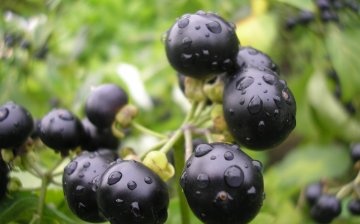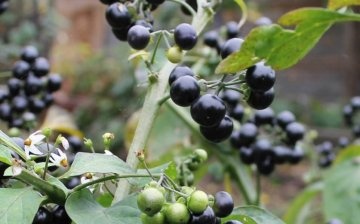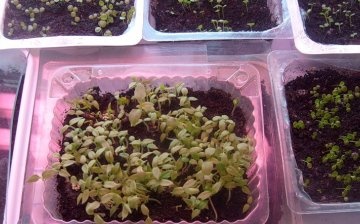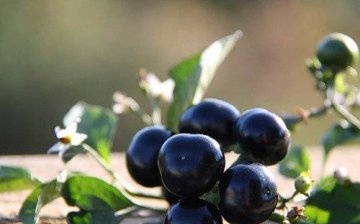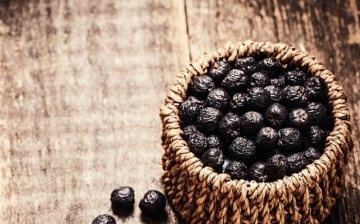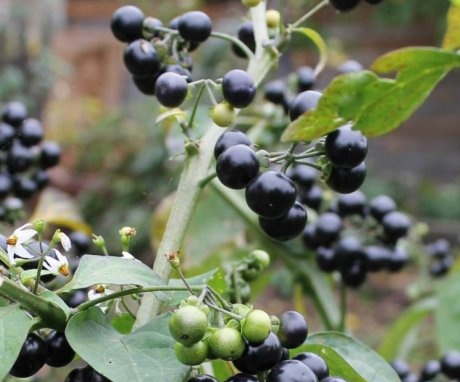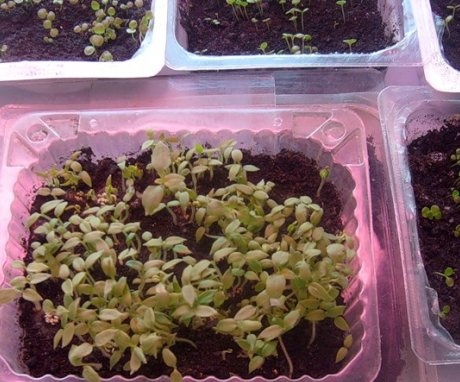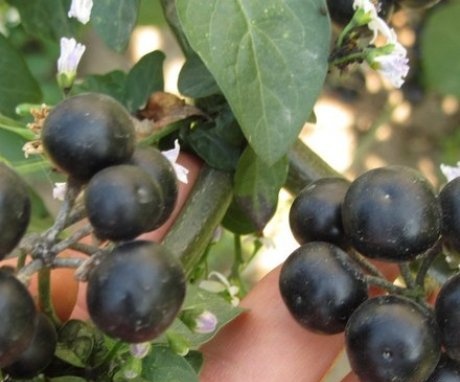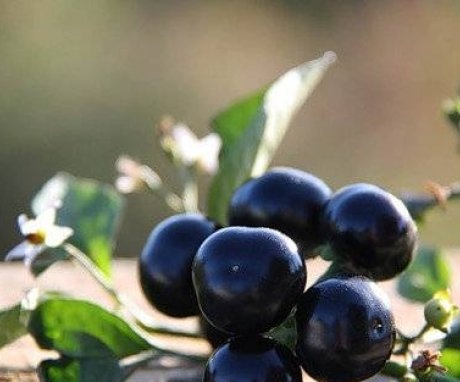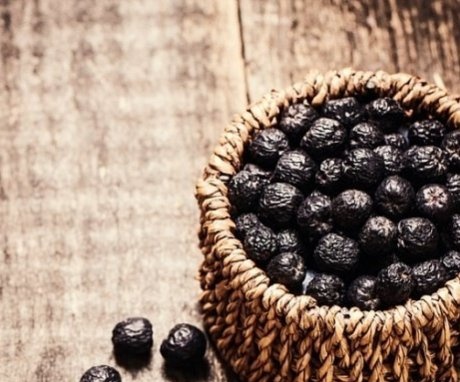Sunberry: cultivation and use
In each garden, weeds are required to be cleaned annually in the spring. Repeatedly it is necessary to remove weeds, including nightshade. Its black berries are poisonous. But the American breeder turned out to be quick-witted and, based on the grass, bred an ornamental plant called the Sunberry.
Content:
- Description of the plant
- Reproduction and planting
- Care Tips
- Useful properties of berries and contraindications
- Application
Description of the plant
Sunberry is a hybrid of the Solanaceae family, bred by crossing the tall Guinean blueberry and the creeping European Solanum villosum in 1905.
Features of the structure of Sunberry:
- The plant grows in the form of a tree or a small bush. It grows upwards by 1.5 - 2.0 meters, and in breadth it can reach 0.8-1.0 meters. It grows in gardens as a perennial.
- The tree boasts a powerful tetrahedral base - a stem. During the period of active growth, numerous stepchildren are formed on it.
- The leaves of the plant are slightly elongated, conical, matte.
- During the flowering period, the bush releases numerous buds. Its flowers are white and resemble stars. They are small in size, located on one peduncle, 10-15 pcs., Tightly to each other. Close to colors in appearance potatoes.
- They bloom for quite a long time - until late autumn. After that, berries are formed, the size of a cherry (up to 1-2 cm in diameter). The location is reminiscent of how cherry tomatoes are grouped.
The bush is not afraid of frost, for it a comfortable temperature is -50C. The ripening period in fruits is quite long. An indicator of maturity is the rich charcoal shade of the fruit.
The fruit yield is very high - 5 bushes together give a bucket of berries. They do not crumble and can hang on the branch for a long time, do not rot, only slightly wither. The collection period starts in mid-October.
Ripe fruits have a rich, bright and unusual taste.
In a green state, the fruits are poisonous, like that of a common weed. But when the berries are ripe, their value increases several times. The plant does not require additional care, is not afraid of bad weather and ripens in any conditions. In addition, it does not completely depend on water supply, it can tolerate a rather dry summer. But under such conditions, the fruits will be few and small.
Reproduction and planting
Reproduction of decorative culture occurs only seeds... Planting material must be purchased in specialized stores. Otherwise, there is a chance, instead of a rare shrub, to plant an ordinary weed.
You can plant seeds in any soil, the bush does not reveal specific preferences. The only drawback found in a plant is that if it is planted in acidic soil, the yield will decrease dramatically.
The tree is welcomed to land with abundant fertilizing of manure.
The best substrate on which they planted last year zucchini and cucumbers... Can also be planted between rows, among vegetable plantings. But next to tomatoes, potatoes, eggplant and pepper better not to post. The shrub begins to grow poorly, sharply slows down growth, and reduces the formation of buds. Although the plant is a perennial, it is most often grown as an annual shrub.This is due to the fact that in the first year the harvest is much more numerous than in subsequent periods.
It is not worth planting seeds in the ground right away. Better to apply the cultivation method seedlings:
- Sowing is carried out in late February - early March. Before planting, the seeds are soaked in a weak solution of potassium permanganate for about 30 minutes. Necessary for disinfection and better seed germination. Then it is recommended to rinse the planting material under running water.
- The next step is to carefully cut off part of the seed peel so that the plant germinates faster. Sunberry is a long-growing bush, so that the sprout grows faster, they open the way for it.
- The incision should be done very carefully, calculating the place where the first timid sprout should appear.
- Then the seeds are placed in a damp place - wrapped in a wet cloth, napkin or moistened toilet paper. Actions are necessary for the embryo to hatch. Then the moistened seedlings should be placed in a warm, sunny place for several days to hatch.
- While the planting material is being prepared, the soil and flowerpot should be prepared. Be sure to put drainage on the bottom of the container. It is necessary that the water does not stagnate in the flowerpot.
- Sprouted seeds are planted in prepared soil to a depth of no more than 0.5-1 cm. Otherwise, the seedling may rot. The pot should not be covered with anything or made greenhouse conditions. It is enough to periodically irrigate moderately (3-4 times) a week and not increase the temperature in the room, adhere to 22-240C.
- The first shoots will appear only after 3 months. After they can be separated from each other in their own flowerpot. It is better to replant with the help of transshipment - capturing a large lump of earth, so as not to damage root system plants. After completing the transplant, identify the bushes in a sunny place.
When the sprout can please with 5-7 full-fledged leaves, it is recommended to transplant it into garden soil. This happens most often in May-June. Then top dressing is needed. mineral, and in the fall organic fertilizers.
In open ground, the plant is planted so that there is a distance of at least 70 cm between the bushes. But it is worth taking a closer look at the neighbors in the garden. Should not be placed next to cabbage. She has a parasite - a cruciferous flea. It tends to hit the flowers and buds of the Sunberry. For protection, you can sit next to green onions, salad.
Care Tips
The plant is not whimsical at all. Watering necessary only when the soil is completely dry and high air temperatures. Due to the fact that the shrub is very productive, when the berries begin to form and ripen, the branches tend to the ground, threatening to break at any time. They must be propped up or tied to a peg or support.
Towards the end of summer, starting in mid-August, it is necessary to prune new buds that are formed.
This is necessary for the plant to direct all its forces to the already existing fruits. So you can influence the acceleration of ripening and an increase in the size of the berries. It is periodically recommended to loosen the ground near the tree trunk. Such activities will improve the growth and development of the roots. You should also remove the weeds around.
Thus, the conditions of care are not particularly difficult. The shrub grows on its own, you only need to prune new flowers in the fall, all the same, they will not ripen to a full harvest.
Useful properties of berries and contraindications
Sunberry boasts a high content of beneficial trace elements and vitamins. Vitamin C contributes to the following body processes:
- Prolongation of youth and slowing down of old age.
- Stimulates collagen production.
- Supports the body's immune system.
- Monitors the normal functioning of blood vessels and capillaries of blood flow.
- It has a beneficial effect on the endocrine and nervous systems.
The carotene contained in the berry removes and neutralizes toxins.Manganese increases human immunity, and also has a beneficial effect on hematopoiesis. Zinc helps to normalize the work of the pancreas. And nickel and copper provoke the formation of red blood cells. The combination of useful substances helps in the cure of joint diseases, saturates the blood composition, increases clarity and visual acuity, improves digestion, sleep, and normalizes appetite.
The medicinal properties of the berry:
- Has antimicrobial properties.
- Affects the digestive organs.
- The blood is renewed and affects the improvement of its composition.
- Normalizes blood pressure.
- The elasticity of blood vessels increases.
- Compresses are helpful in treating skin conditions.
- Fried and mashed fruits improve healing.
- Eliminate pain in the head and joints.
When using it, it should be borne in mind that the plant is a strong allergen, not everyone can eat it. It provokes uterine contractions and miscarriages. Therefore, it cannot be eaten during pregnancy. Not recommended for drivers as it has soothing properties.
You should not abuse the product, the norm per day is 2 handfuls of fruits. When overeating, an allergic reaction manifests itself in the form of itching and rashes. It is strictly contraindicated in young children under 12 years of age. Overweight people should not eat berries, they are high in calories. 100 g contains 200 kcal. If you eat 200-300 grams, then a laxative effect may appear.
Application
It can be consumed fresh, initially pouring boiling water over it. The product is used to make jams, pie fillings or compotes. It is not stored for a long time, so something urgently needs to be done. Berry jam has a very bright taste. They are passed through a meat grinder and boiled for only 5 minutes. Lemon juice can be added. He will saturate the jam with an amazing aftertaste.
The berries contain a large amount of pectins that help to solidify. Due to this quality, jelly is prepared. The preparation process is the same for jam, but after squeezing through a meat grinder, you should additionally grind through a sieve, thereby separating the bones and peel. Then boil over low heat.
Thus, the fruits are not only tasty, but also healthy.
Very worthy delicacies are obtained by combining Sunberry with cranberries, barberries, gooseberries, red currants. An interesting taste is observed when the fruits are rolled in tomato juice. The berries are poured over with boiling water and immediately poured with tomato juice into sterilized jars. Then you need to lower the containers in boiling water and roast in this form for up to half an hour, close.
The fruits are used in the form of a medicine for gastritis, colic. They are often recommended for diabetics. Has established itself as a good remedy for sore throat and colds. Has a positive response for varicose veins and angina pectoris. It is noted to thin the blood. In case of food poisoning, a small amount of eaten berries acts as a natural sorbent. Regular use neutralizes constipation and spasms of the gastrointestinal tract.
More information can be found in the video:



